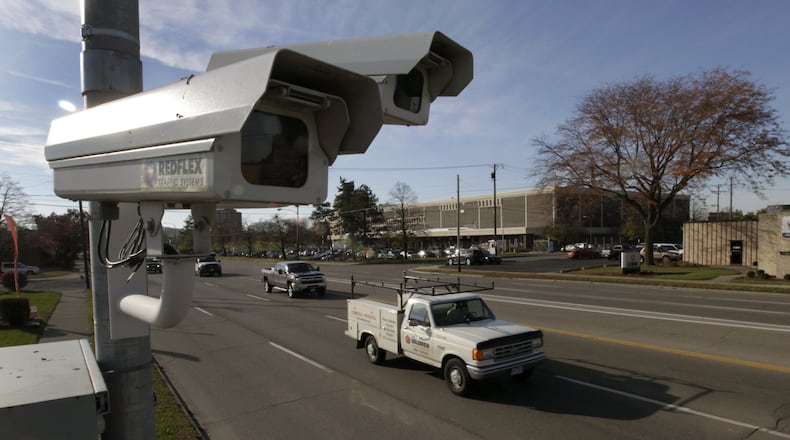The Dayton Police Department will comply with state law and will only document and cite motorists for traffic violations caught on camera when officers are present at the equipment, said Dayton police Chief Richard Biehl.
DOWNLOAD OUR MOBILE APPS FOR LATEST BREAKING NEWS
The cameras will be in use part of the time, because the police department has limited resources, but traffic crash data clearly show that the cameras make Dayton’s roads safer, Biehl said.
“Camera traffic enforcement has always been a very effective way to control hazardous driving, and so we’re obviously making a recommendation to return to that,” Biehl said.
The Dayton Police Department’s photo enforcement program began in 2003 and ended in July 2015 after the Ohio Supreme Court ruled that a sworn officer must be present in order to issue tickets.
»RELATED: 5 things to know about Dayton’s red-light camera case
State lawmakers passed legislation placing that and other requirements on use of the devices, but some Ohio cities challenged the constitutionality of the law. Dayton is still fighting to get key components of the law struck down.
Critics have accused cities of using traffic cameras primarily to generate revenue, and some have claimed that they are unconstitutional because they skirt due process and other protections.
“I have always maintained that photo-enforcement cameras were more about money than safety,” Ohio Sen. Bill Seitz, R-Cincinnati, who sponsored the legislation restricting use of the technology, told this news outlet in the past.
But Dayton’s cameras continued recording until the end of 2015 for data collection.
»RELATED: Dayton to shut down traffic cameras
The data showed big spikes in speeding and red-light violations at the intersections when the cameras were no longer used to issue citations, said Dayton police Detective Jason Ward.
Since 2014, crashes citywide increased 40 percent and traffic deaths increased 45 percent, according to Dayton police.
Police identified the top 25 crash intersections, and the police department plans to install fixed cameras at sites based on a three-year analysis of crash data, as required by state law, Ward said.
The mobile and hand-held devices are speed-detection cameras. The fixed cameras are expected to be a mix of speed-detection and red-light cameras.
Deployment of the hand-held and trailer traffic cameras will be based on residents’ complaints and when neighborhoods or officers request them, Ward said.
»RELATED: City wants to restart photo-enforcement traffic program
The cameras at fixed locations are expected to be operational and issuing fines for traffic violations roughly about eight hours each week per site, Ward said.
“That will be subject to staffing and operational considerations,” he said.
The first 30 days of the program are required to be a warning period, in which motorists will receive warnings in the mail instead of fines.
The city also will conduct a public awareness campaign to inform motorists about the reintroduction of the cameras and the locations of the fixed devices.
The camera technology will be used selectively because of resource and manpower limitations, Biehl said.
The program requires legislative action by the Dayton City Commission.
But commissioners have repeatedly said that the city became less safe when the traffic cameras were turned off.
Cameras change motorists’ behavior and get citizens to drive at safer speeds, said Dayton Mayor Nan Whaley.
BY THE NUMBERS
Dayton’s seen an increase in crashes and traffic deaths after enforcement cameras were blocked by a state law change.
2014: 16 traffic fatalities, 3,093 injury/property crashes
2016: 30 traffic fatalities, 4,326 injury/property crashes
UNMATCHED COVERAGE
The city of Dayton is expected to resume using speed-detection and red-light cameras, which for years have been controversial public safety tools. This newspaper has been the leading source of news about traffic cameras and lawmakers’ attempts to reduce police agencies’ reliance on technology vs. Ohio cities’ efforts to keep them rolling. We have provided unmatched coverage of this issue, which impacts safety, motorists and government coffers.
About the Author

